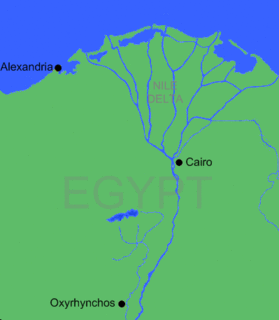Papyrus Oxyrhynchus 50 is a receipt concerning the emancipation of a slave of a banker, written in Greek. The manuscript was written on papyrus in the form of a sheet. It was discovered by Grenfell and Hunt in 1897 in Oxyrhynchus. The document was written before the year 99. It is housed in the library of Trinity College in Dublin. The text was published by Grenfell and Hunt in 1898.
Papyrus Oxyrhynchus 84 records a payment to the guild of ironworkers, and is written in Greek. The manuscript was written on papyrus in the form of a sheet. It was discovered by Grenfell and Hunt in 1897 in Oxyrhynchus. The document was written on 1 November 316. Currently it is housed in the British Museum (759) in London. The text was published by Grenfell and Hunt in 1898.

Papyrus Oxyrhynchus 89 is a receipt for the payment of wheat, written in Greek. The manuscript was written on papyrus in the form of a sheet. It was discovered in Oxyrhynchus. The document was written on 29 July 140. Currently it is housed in the Egyptian Museum in Cairo.
Papyrus Oxyrhynchus 90 is a receipt for the payment of wheat, written in Greek. The manuscript was written on papyrus in the form of a sheet. It was discovered in the Egyptian city of Oxyrhynchus. The document was written between 179-180. Currently it is housed in the British Museum (761) in London. It is known also as P. Lond. 3 p. XXXII no. 761.
Papyrus Oxyrhynchus 91 is a receipt for wages for wet nursing, written in Greek. The manuscript was written on papyrus in the form of a sheet. It was discovered in Oxyrhynchus. The document was written on 13 October 187. Currently it is housed in the library of the Royal Holloway College in Egham.
Papyrus Oxyrhynchus 98 is a letter acknowledging the repayment of a loan, written in Greek. It was discovered in Oxyrhynchus. The manuscript was written on papyrus in the form of a sheet. It is dated to between 141 and 142. Currently it is housed in the British Museum (764) in London. It is also known as P. Lond. III 764.
Papyrus Oxyrhynchus 107 is an acknowledgement of receipt of a will, sent in regard to its revocation. It is written in Greek and was discovered in Oxyrhynchus. The manuscript was written on papyrus in the form of a sheet. The document was written on 27 February 123. Currently it is housed in the Egyptian Museum in Cairo.
Papyrus Oxyrhynchus 134 is the second in a series of Oxyrhynchus papyri (133–139) concerning the family affairs of Flavius Apion, his heirs, or his son. This one is a receipt from a stonemason given to Flavius. It is written in Greek and was discovered in Oxyrhynchus. The manuscript was written on papyrus in the form of a sheet. The document was written on 9 June 569. Currently it is housed in the Egyptian Museum (10053) in Cairo.
Papyrus Oxyrhynchus 137 is the fifth in a series of Oxyrhynchus papyri (133–139) concerning the family affairs of Flavius Apion, his heirs, or his son. This one is a receipt for a water wheel axle, written in Greek and discovered in Oxyrhynchus. The manuscript was written on papyrus in the form of a sheet. The document was written on 11 January 584. Currently it is housed in the Egyptian Museum (10034) in Cairo.
Papyrus Oxyrhynchus 145 is a receipt, written in Greek and discovered in Oxyrhynchus. The manuscript was written on papyrus in the form of a sheet. The document was written on 15 March 552. Currently it is housed in the Egyptian Museum (10066) in Cairo.
Papyrus Oxyrhynchus 146 is a receipt, written in Greek and discovered in Oxyrhynchus. The manuscript was written on papyrus in the form of a sheet. The document was written on 15 November 555. Currently it is housed in the Egyptian Museum (10076) in Cairo.
Papyrus Oxyrhynchus 147 is a receipt, written in Greek and discovered in Oxyrhynchus. The manuscript was written on papyrus in the form of a sheet. The document was written on 7 April 556. Currently it is housed in the Egyptian Museum (10074) in Cairo.
Papyrus Oxyrhynchus 148 is a receipt, written in Greek and discovered in Oxyrhynchus. The manuscript was written on papyrus in the form of a sheet. The document was written on 12 April 556. Currently it is housed in the Egyptian Museum (10075) in Cairo.
Papyrus Oxyrhynchus 149 is a receipt, written in Greek and discovered in Oxyrhynchus. The manuscript was written on papyrus in the form of a sheet. The document was written on 22 September 572. Currently it is housed in the Egyptian Museum (10045) in Cairo.
Papyrus Oxyrhynchus 150 is a receipt, written in Greek and discovered in Oxyrhynchus. The manuscript was written on papyrus in the form of a sheet. The document was written on 7 October 590. Currently it is housed in the Egyptian Museum (10051) in Cairo.
Papyrus Oxyrhynchus 151 is a receipt, written in Greek and discovered in Oxyrhynchus. The manuscript was written on papyrus in the form of a sheet. The document was written between 28 September and 27 October 612. Currently it is housed in the Egyptian Museum (10094) in Cairo.
Papyrus Oxyrhynchus 152 is a receipt, written in Greek and discovered in Oxyrhynchus. The manuscript was written on papyrus in the form of a sheet. The document was written on 1 March 618. Currently it is housed in the Egyptian Museum (10048) in Cairo.
Papyrus Oxyrhynchus 153 is a receipt, written in Greek and discovered in Oxyrhynchus. The manuscript was written on papyrus in the form of a sheet. The document was written on 20 May 618. Currently it is housed in the Egyptian Museum (10044) in Cairo.





